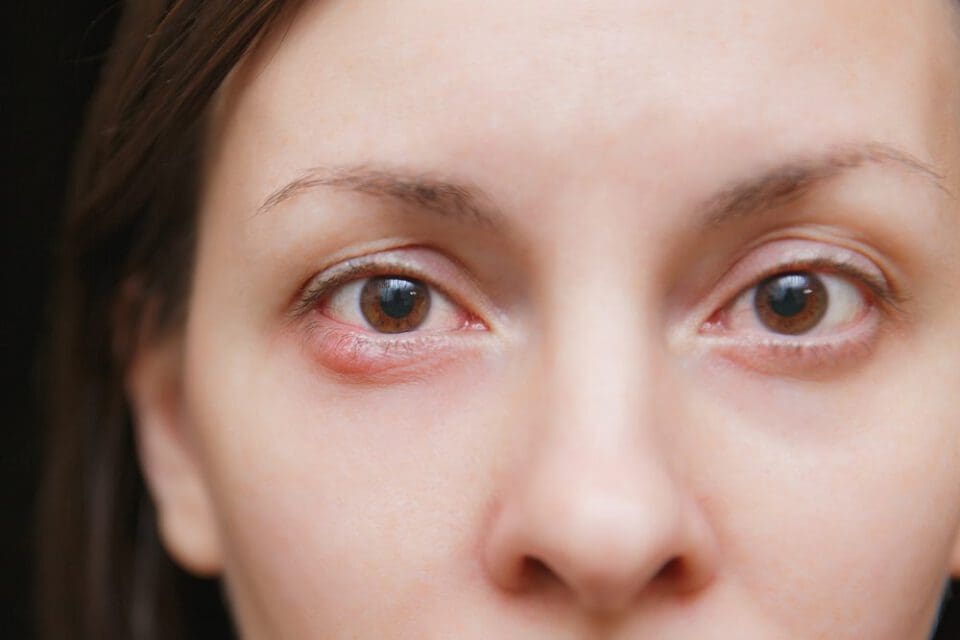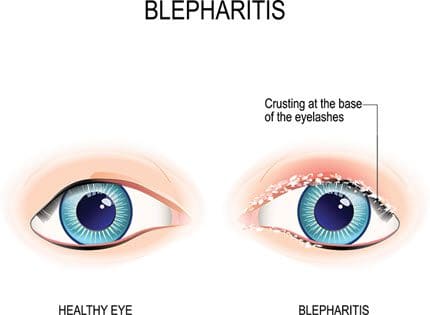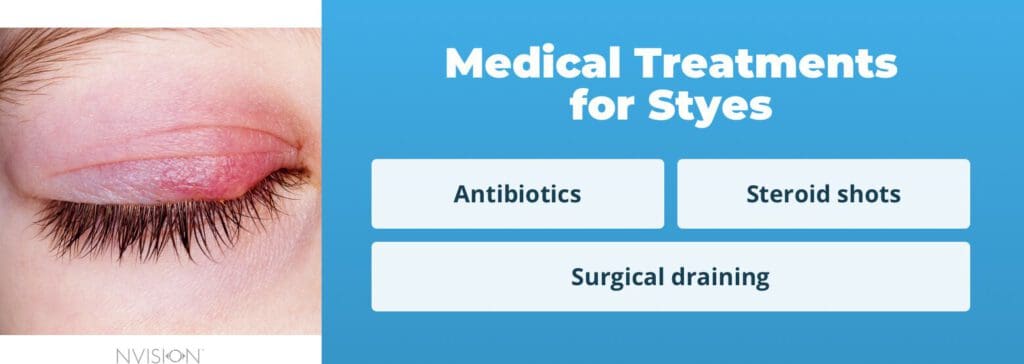
Medically Reviewed by Tom Tooma, M.D., Founder/Medical Director
Further Reading
How To Completely Get Rid of a Stye
Home / Eye Conditions & Eye Diseases /
Last Updated:

Medically Reviewed by Tom Tooma, M.D., Founder/Medical Director
A stye is a lump that forms on the eyelid near the eyelash base. It is caused by a bacteria infection of an oil gland in the eyelid. Styes usually present as a red, sore bump on the edge of the eyelid, but can be internal or external. They can appear on either the upper or lower eyelid.
Left alone, styes are considered not very serious and usually clear up after a few days. However, in a case of chronic infection or severe cases, you may want to consult a doctor. Styes can also be associated with other medical conditions which will require treatment.
Table of Contents

What Are Styes?
Styes always occur on the eyelid itself. They mostly happen on the exterior eyelid, but sometimes crop up on the inner eyelid. They tend to be painful, red, and inflamed. They may also have a small, lighter colored spot at the center of the bump, exactly like acne. There may also be some crust or discharge along the eyelid edge or the stye itself.
Styes may cause a great deal of discomfort, and cause the affected eye to be sensitive to light, temperature, and touch. They may produce the sensation of something stuck in your eye, or cause the eye to produce tears.
You deserve clear vision. We can help.
With 135+ locations and over 2.5 million procedures performed, our board-certified eye surgeons deliver results you can trust. Your journey to better vision starts here.
Causes of Styes
Everyone is at risk for styes, which can happen at any age. Styes are simply caused by a buildup of bacteria. There are certain conditions which increase the risk of styes, and having styes might even be a sign of the presence of an aggravating condition.
- Blepharitis, a condition characterized by oily flakes and bacteria at the eyelash base causing swelling, redness, and a burning sensation of the eyelid
- Seborrheic dermatitis, acne rosacea, or a similar skin condition
- A history of styes
- Having diabetes
- Having high cholesterol
- Having skin conditions like dandruff
- Having hormonal changes

Styes vs Chalzion
You should be sure to distinguish the difference between a stye and a chalzion before beginning treatment. When an oil gland in the eyelid gets clogged, a chalazion can develop. It takes the form of an eyelid bump, usually on the inside of the eyelid.
A chalazion can begin as an internal stye. A chalazion might not be apparent at first since it is often painless, or the pain is minimal. But as it gets bigger, the affected eyelid can become swollen, red, and tender when someone touches it.
Once a chalazion gets big, blurry vision can occur if someone presses on the eye. In rare cases, the entire eyelid can become swollen.
Telling the difference between a stye and a chalazion comes down to two factors:
- The pain of a stye is typically significant, while the pain of a chalazion is minimal, if felt at all.
- With a stye, the whole eyelid can sometimes be affected. With a chalazion, it is rare that the whole eyelid swells.
Home Remedies

In cases where a stye is recent and not severe, simple treatments at home can work to help clear it up as soon as possible:
Start with a warm compress. Take a clean washcloth and soak it with warm water. Squeeze out the excess water and place it on the affected eye for approximately 10 minutes. Never use hot water since this could burn the delicate skin around the eyes. Do this about four times per day, using a clean washcloth each time.
Wash with baby shampoo. Use baby shampoo or any gentle soap that doesn’t burn your eyes. Apply gently with a cotton swab or washcloth.
Keep it clean. It is important to keep the affected eye clean, preferably with warm water and something gentle like tear-free baby shampoo. Doctors might also recommend a saline solution to break down bacterial membranes and promote drainage.
Forego contact lenses or makeup. You want the area to be clean and open to the air to let natural draining occur.
Take pain medication. Since styes can cause significant pain, an over-the-counter pain medication may be recommended to reduce discomfort. Doctors may suggest acetaminophen or ibuprofen.
Before using any home remedy, it is important to consult a doctor. They can advise on how to properly use these methods. They will also accurately diagnose a stye and instruct on the best treatments for the particular situation.
In some instances, home remedies will not be sufficient, and medical treatment could be necessary.
When To See A Doctor
You should consult a medical professional with a stye if any of the following occur:
- The stye hasn’t improved after a week
- It gets worse quickly
- It grows in size
- It bleeds
- It affects your vision
- You run a fever
- The infection spreads to the rest of your eye
- You see redness in the eye, or skin around the eyelid
Everyone’s immune system is different, and while some people can fight off an infection, others struggle against every stray bacterium that comes their way. If you know that you have a history of eye infections or trouble with infections in general, seek medical advice sooner rather than later.
You deserve clear vision. We can help.
With 135+ locations and over 2.5 million procedures performed, our board-certified eye surgeons deliver results you can trust. Your journey to better vision starts here.
Medical Treatments

Typically, most styes clear up on their own within 48 hours, with or without home treatments. If you have a stye lasting longer and a doctor determines that medical intervention is needed, it can take any of the following forms:
Antibiotics
Antibiotics fight infections. In the case of a stye, your doctor might prescribe either eye drops, to be applied directly to the eye, or an ointment, to be applied to the eyelid. In some cases, a general antibiotic (oral dose) may be prescribed if the infection has spread.
Steroid Shots
Inflammation and swelling can occur when someone has a stye. If these are significant, the doctor might recommend an injection to reduce both the inflammation and swelling. The injections use corticosteroids.
The doctor uses a small needle for this to reduce the risk of discomfort. The total procedure only takes a few minutes. Before administering the injection, the doctor may numb the area to further reduce discomfort.
Surgical Draining
If other methods fail or the condition persists aqnd threatens the patient’s vision, the doctor might recommend surgically draining the stye. While this is a rare measure, superficial cellulitis may develop as a result of a stye, which can lead to a more serious infection. A chalazion may also develop from an untreated stye.
This procedure is done in the doctor’s office. Following the drainage, the doctor might also prescribe antibiotics for up to ten days to clear the infection.
If a chalazion develops from a stye and does not go away after a month or two of other treatments, the doctor may recommend surgically draining it. This procedure is also performed in the doctor’s office and takes approximately fifteen to twenty minutes. The doctor numbs the eyelid before making the small incision to drain it. Within the nodule, any material and fluid are removed and drained. In most cases, people do not need stitches after this surgery.
Following the procedure, the doctor may prescribe antibiotic eye drops or cream for approximately one week. A pressure patch may also be applied to the eye.
Other Possible Treatments
In addition to these treatments, there are eyelid scrubs that may be beneficial. There are different types of scrubs available, some similar to a shampoo. To use them, gently scrub the stye and surrounding area.
Scrub formulas may contain different active ingredients, such as melaleuca alternifolia, or hypochlorous acid, or 4-terpineol, which may be indicated if the patient has underlying blepharitis.
Since styes are a type of bacterial infection, ignoring them is not advised. Make sure to only used approved treatments and talk to a doctor if the stye gets worse or does not improve.
Preventing Future Styes
While some people are just prone to styes, there are a few actions we can all take to minimize the occurrence of styes. Most of these come down to practicing cleanliness.
- Good hygiene: Always wash your hands thoroughly before touching your eyes.
- Remove eye makeup: Cleanse your face every night, carefully removing all makeup from around your eyes. Never go to bed with makeup on.
- Use clean towels and washcloths: Never use a dirty towel around your eyes.
- Replace outdated makeup: Bacteria can form on old makeup. Aim to replace all eye makeup every six months.
- Never share eye makeup with anyone else: You can pass bacteria around from person to person easily.
Frequently Asked Questions
STYE QUESTIONS
Can You Remove a Stye?
While a stye is not technically removed from the eye, it can be surgically drained if other treatment methods fail to provide relief. See the “medical treatment” section above.
Can You Pop a Stye?
You should never do this! This could increase the risk of further infection that could spread into the eye. A stye is not the same thing as acne. Nor should you rub or massage a stye, which can run the same risk.
Can Coconut Oil Treat a Stye?
No, do not use coconut oil. This is an old quack remedy. While coconut oil does possess anti-microbial and anti-inflammatory properties, it’s not accepted as a safe treatment for styes.
Are Styes Contagious?
No, there is no known contagious stye. They are not spread through contact with other people. However, since they develop due to bacteria, you could spread bacteria to your other eye that may lead to a stye there. And again, if you share makeup from one person to another, you can contaminate your eyes with foreign bacteria which can foster a stye.
You deserve clear vision. We can help.
With 135+ locations and over 2.5 million procedures performed, our board-certified eye surgeons deliver results you can trust. Your journey to better vision starts here.
References
- Stye and Chalazia. American Academy of Ophthalmology.
- Who Is at Risk for Chalazia and Styes? American Academy of Ophthalmology.
- Is It OK to Pop a Stye? American Academy of Ophthalmology.
- Treatment and Symptoms of a Stye on the Eyelid. Verywell Health.
- Sty (Stye): Management and Treatment. Cleveland Clinic.
- The 8 Best Stye Remedies. Healthline.
- What Can I Do About a Stye? Medical News Today.
- Surgery for Style. New York University Langone Health.

Dr. Tooma, the founder of NVISION® Eye Centers, has performed well over 130,000 LASIK surgeries, making him the most experienced LASIK surgeon in the Western United States.
This content is for informational purposes only. It may have been reviewed by a licensed physician, but is not intended to serve as a substitute for professional medical advice. Always consult your healthcare provider with any health concerns. For more, read our Privacy Policy and Editorial Policy.